Vinyl records, revered for their warm analog sound and nostalgic appeal, have experienced a resurgence in popularity among music enthusiasts. However, the quality of a vinyl record can greatly influence the listening experience. A bad vinyl record can result in distorted sound, skips, and other undesirable audio artifacts. Understanding the signs of a flawed vinyl record is essential for collectors, audiophiles, and anyone seeking an optimal auditory journey. This article aims to delve into the intricacies of identifying a bad vinyl record, exploring its causes, and offering insights into preserving the integrity of your vinyl collection.
The Art of Visual Inspection:
- Surface Imperfections:
- Scratches: Scratches on the surface of a vinyl record can cause audible distortion. Deep scratches may produce skips or repeat certain portions of the track.
- Scuffs: Light scuffs might not affect playback significantly, but extensive scuffing can lead to reduced audio quality.
- Fingerprints and Dust: Fingerprints and dust particles can create unwanted noise and distortion during playback. Regular cleaning is essential to maintain pristine sound quality.
- Warps and Warping:
- Warped vinyl records, where the disc deviates from its flat shape, can result from improper storage or exposure to heat. Warps cause the stylus to fluctuate, impacting playback quality and causing distortion.
- Pressing Defects:
- Off-center Holes: Records with off-center holes can lead to uneven rotation on the turntable, causing pitch fluctuations.
- Bubbles: Air bubbles trapped during the pressing process can create bumps on the record’s surface, resulting in clicks and pops during playback.
Auditory Clues:
- Audible Distortions:
- Clicks and Pops: Clicking and popping sounds often indicate dust, debris, or minor imperfections on the vinyl’s surface. Excessive clicks and pops might result from deeper scratches.
- Hiss and Crackling: Continuous hissing and crackling can be attributed to surface damage, worn-out stylus, or improper storage.
- Tracking Issues:
- Skipping: A stylus that skips ahead or backward within a track suggests tracking problems. This can be due to warps, scratches, or incorrect stylus alignment.
- Inner Groove Distortion: Records with inner grooves may exhibit distortion due to the narrower space available for audio information.
Playability and Groove Wear:
- Groove Wear:
- As vinyl records are played repeatedly, the friction between the stylus and the groove causes gradual wear. This wear diminishes sound quality over time, resulting in a loss of high frequencies and increased surface noise.
- Vinyl Condition and Care:
- Proper Handling: Touching the playing surface with bare hands can transfer oils and dirt, leading to degradation in sound quality. Handling records by their edges is essential.
- Storage: Storing records vertically and away from direct sunlight and heat helps prevent warping and deterioration.
Diagnosing and Remedying Issues:
- Visual Inspection:
- Use proper lighting and angle to examine the record’s surface for scratches, scuffs, and warps.
- Cleaning the Record: Employ antistatic brushes, cleaning solutions, and microfiber cloths to remove dust and dirt.
- Auditory Analysis:
- High-quality headphones and speakers are necessary for precise sound evaluation.
- Use a magnifying glass to inspect the grooves for deep scratches and imperfections.
- Turntable Maintenance:
- Ensure proper stylus alignment and tracking force.
- Regularly clean the stylus and turntable components.
Conclusion:
Recognizing the signs of a bad vinyl record enhances the appreciation of your music collection. Through a careful visual inspection and attentive listening, enthusiasts can identify imperfections that compromise audio quality. By understanding the causes and solutions for common issues like scratches, warps, and groove wear, audiophiles can prolong the lifespan of their vinyl records and embark on a musical journey that truly captures the magic of analog sound.


